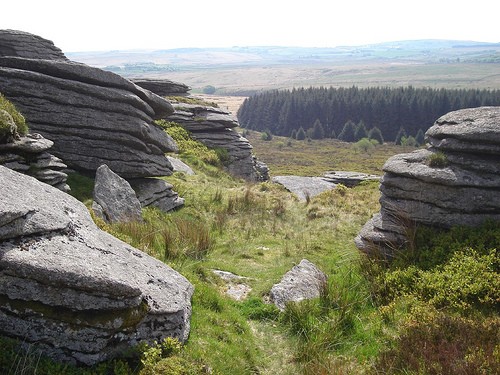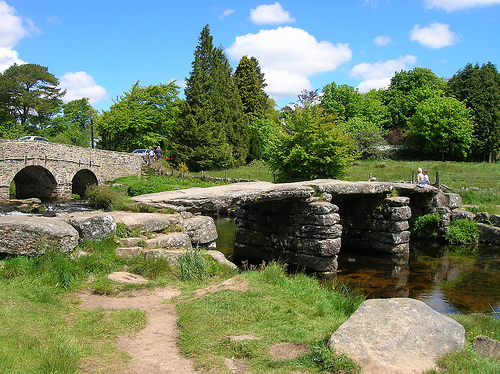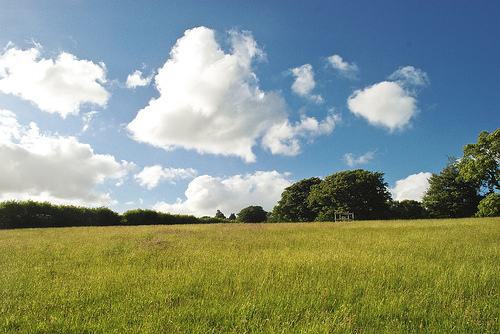

Location: Devon Map
Area: 368 sq mi (953 sq km)
Highest point: 2,038 ft (621 m)
Visitor Centre, Princetn (01822- 890414)
Museum of Dartmoor
Life
West St., Okehampton
Tel. 01837 52295
Open: 10:15am-
4:15pm Tue & Fri
Closed: 24 Dec- 1 Jan
Castle Drogo
Drewsteignton
Tel. 01647 433306
Open: Apr- Nov: Wed- Mon
Dartmoor is a hilly region in the English county of Devon. The mostly
moor and heath-bearing leveled areas of the granite massif are towered
over by a large number of so-called tors, flat meadow hills with granite
rock formations up to 10 meters high. The highest point on Dartmoor is
High Willhays or High Willes at 621m. 954 km² of the landscape is
designated as Dartmoor National Park. Numerous remains of Bronze Age
dwellings, field systems and stone circles can be found on Dartmoor. The
so-called clapper bridges made of thin granite slabs are also
characteristic.
prehistory and the Middle Ages
The oldest
traces of human habitation in Britain were found in the limestone caves
near Torquay alongside Cheddar Gorge or Kents Cavern. Many of the
archaeological find complexes on Dartmoor date from the Neolithic
(Spinster's Rock) and Bronze Age (2000 to 500 BC). In addition to stone
circles, over 2000 round hut floor plans are registered. Examples can be
found at Grimspound. There are also a large number of stone rows and
menhirs to be found. Iron Age fortifications can also be found at higher
altitudes. The largest such facility is Hembury Fort.
Devon, a
county since the 8th century, was the target of Viking and Danish raids
in 851 and 1003 respectively. Most of the forts built in Anglo-Saxon
times and after the Norman conquest, such as Exeter, Barnstaple, Totnes
and Lydford, as well as Okehampton and Plympton, were the nucleus of the
later cities.
Tourism has long been an important economic factor in the region. In addition, agriculture, which is primarily based on sheep and cattle breeding, is the main source of income. You can ride Dartmoor ponies in numerous places. This wild moorland pony is Britain's oldest pony breed. The animals are sold at special markets and make excellent riding horses for children. HMP Dartmoor Prison is located in the middle of the moor near Princetown. It became known in the early 1980s through a revolt that was triggered, among other things, by the poor hygienic conditions prevailing there.
Remains of old smelting furnaces and deserted mining
settlements are reminiscent of the former importance of tin and copper
ore mining for the region. This era, during which the miners formed
their own communes with their own jurisdiction, lasted from the 12th to
the 17th century. Lead, silver and iron ore as well as copper and
manganese were mined on a smaller scale up until the 19th century. The
surrounding port cities of Exeter, Plymouth, Barnstaple and Dartmouth
also benefited from tin and textile exports from the Middle Ages until
the final decline began in the 19th century. Only the exploitation of
the kaolin deposits discovered in the 18th century could be continued.
The emigration of the rural population associated with this development
was mitigated by the increase in tourism that accompanied the expansion
of the railway network.
water for the region
The peat layer
that covers Dartmoor is able to store large amounts of water and then
release it as leachate. This ability to regulate the water balance of
the plateaux and prevent flooding brought the use of Dartmoor for the
water supply of towns and communities to the fore from the 16th century
onwards.
The first city to implement regular water supply from
outside its borders on this basis was Plymouth. Sir Francis Drake
directed the construction of the required waterway, which was completed
in 1591. Two hundred years later, Devonport took up this approach again
and became the second city to draw its water from Dartmoor. The first
dam was built in 1898 and later extended again, again by Plymouth. In
1907 the town of Paignton built its causeway, followed by many others.
Since then, a number of other towns and cities have built dams and laid
mains, and today virtually all of the surrounding region gets its water
from Dartmoor.
Established in 1951, Dartmoor National Park aims to
help preserve the area's originality, protect its archaeological remains
such as the stone circles on Dartmoor and the megalithic complexes of
Merrivale, The Graveyard and Grimspound, its flora and fauna. 17,000
hectares or 16 percent of the park is designated as either a protected
area or a site of "special scientific interest". Added to this is the
protection of 1,000 hectares of wooded areas. Unlike other national
parks, Dartmoor National Park is not governed by the Rights of Way Act.
This means that the entire park is accessible to pedestrians, they don't
have to stick to the existing paths and roads.
Commercial
pressure and the resulting rapid pace of change on Dartmoor led to the
formation of the Dartmoor Preservation Association in 1883. Today, this
organization still plays a leading role in protecting natural habitats
and maintaining free public access. In this context, efforts are made to
establish good relations with private landowners. The country is largely
owned by the Duke of Cornwall, currently Prince William. 41 per cent of
the park is common land, the use of which has been regulated by the
Dartmoor Commons Act since 1985. Another important concern is the
conservation of animal and plant species.
In February 2021, a
fire broke out in a remote moorland area near Tavistock, spreading five
kilometers wide.
landscape picture
Thirty percent of the
common land is treeless bog at elevations over 1,200 feet (366 meters)
whose thick layer of peat is capable of storing large amounts of water.
In some areas, the heathland is preserved through regular burning.
Nature lovers appreciate the damp but mild climate for hiking.
Attractive forest areas offer variety, for example the Yarner Wood
National Nature Reserve or the Becky Falls area with a waterfall. Three
of these forests probably date from the time when the whole area
belonged to the royal hunting grounds hundreds of years ago. One of them
could be Wistman's Wood. Located north of Two Bridges, it has been a
tourist attraction for more than a century because of its oddly stunted
vegetation. The rich flora with ferns and lichens is also remarkable.
In the park area there is a large selection of picturesque river
courses, along with impressive waterfalls. The waters of the National
Trust's Lydford Gorge, for example, squeeze through a narrow crevice and
whirl down from there into The Devil's Cauldron. Also of note is The
White Lady waterfall, located on the western edge of the park, so named
because a 30 meter high curtain of white water foam forms. In the
Dartmoor area there are few meadows and pastures with spring flowering
flora. Yellow gorse and purple heather color the landscape in August and
September.
For hikers, especially those who know how to read
maps, the possibilities are immense. The paths managed by the park
ranger service alone add up to a total length of 740 kilometers. The
moorland itself is also open to the public.
Hamlets, Villages,
Sights
As well as the better known and lesser known sights of
Dartmoor, attractions include the scattered pretty hamlets and villages;
some of them have been awarded the status of "Conservation Areas" by the
park administration. On the south-east edge of the park, the small town
of Buckfastleigh is worth a visit; from there the South Devon Railway, a
restored standard gauge railway line, travels along the River Dart to
Totnes. Close to the town is the Benedictine abbey of Buckfast Abbey,
one of the few still active monasteries in Britain.
To the
north-east of the park is Castle Drogo, overlooking the Teign River
Valley; it is the last country castle to be built in Britain. Further
downstream is Fingle Bridge, a massive structure with three arches.
Further northwest is Lynford. There is the church of St Michal's de Rupe
on Brentor. Lydford was the first gaol on Dartmoor to be built in 1195,
known for its rude treatment of prisoners.
From the southwest you
drive through the center of the park on old but renovated roads. Via
Bennet's Cross and Warren House, the most remote inn, one arrives at the
village of Postbridge, where the largest surviving 'clapper bridge'
built over the East Dart can be seen. Dating from the 13th century, it
was built to transport tin from the mines to the smelting furnaces of
Tavistock and Chagford by packhorses. The next town is Princetown, known
for HMP Dartmoor Penitentiary, originally built in 1806 for prisoners
from the Napoleonic Wars. The site is also home to the administrative
center of the Duchy of Cornwall. Still in the centre, but in the east
half, is probably Dartmoor's most visited village,
Widecombe-in-the-Moor. The 36 m high tower of the parish church can be
seen from afar. It was built after 1638; That year, during a church
service, a violent lightning struck the building, claiming four lives.

All of Dartmoor, both the landscape and the historical and
archaeological sites, are threatened by the industrial complexes of
Imrey and Watts Blake Bearne. To this day, they have permission from
the British government to exploit the kaolin mines near the moor.
However, there are now efforts to close these mines for conservation
reasons.
The North West part of the moor has been used by the
British Army and Royal Marines for maneuver and target practice
since the Napoleonic Wars. Recently, however, the Open Space Society
and the Dartmoor Preservation Association have opposed this use and
the damage it has caused to the sensitive moorland, with some
success.
There are also problems with using the water from
Dartmoor. The reservoir for the town of Paignton alone covered 33
hectares and since then the number of dams and reservoirs has
steadily increased. The damage this is causing to Dartmoor National
Park has also become a topic of debate.
The barren moorland of Dartmoor has always fired the imagination of
writers in a special way. The Plymouth poet N. T. Carrington wrote
the poem Dartmoor in 1826. King George IV was so impressed by the
work that he had the poet paid 50 guineas.
A description of
the region was given by Richard Doddridge Blackmore in one of his
lesser-known novellas, Christowell, a Dartmoor Tale in 1881.
The cycle of novels by Eden Philpotts, which began in 1898 and
covers the entire region, has become popular.
Arthur Conan
Doyle captured the bleakness and often mystical mood of the Dartmoor
landscape in his detective thriller The Hound of the Baskervilles.
Dartmoor is also the setting for Silver Blaze, a short story about
Sherlock Holmes and Dr. Watson spins.
As a young woman,
Sabine Baring-Gould roamed the barren landscape of Dartmoor alone,
following his pronounced penchant for the supernatural.
In
the course of the Edgar Wallace films of the 1960s, the German crime
film Das Wirtshaus von Dartmoor was made in 1964 based on the novel
by Victor Gunn (actually Edwy Searles Brooks; 1889-1965). However,
the “Dartmoor shots” of the film were made in West Berlin.
The Mystery of Sittaford by Agatha Christie (originally The Murder
at Hazelmoor, 1931) is set in a fictional town of Sittaford on the
edge of Dartmoor.
The book Five Friends in the Mist by
popular children's book author Enid Blyton is also set on Dartmoor.
The abandoned railway and the still existing railway lines play a
major role in this. Five Friends and the Monster on the Moor is also
set on Dartmoor; This episode deals with letterboxing, which is
popular on Dartmoor.
Gilbert Adair's novel Murder at ffolkes
Manor is also set in a mansion on the outskirts of Dartmoor.
The fourth novel in Simon Beckett's David Hunter series, Decay is
partly set on Dartmoor.
This area is also the setting for
Jenny-Aline Veitinger's novel Im Schatten des Dartmoor.
Dartmoor continues to be largely the setting for Teri Terry's Book
of Lies. Here, too, the myths and legends surrounding demonic dogs
from hell, so-called hounds, are an important element of the plot.
The psychological thriller The Girl from the Moor is also set on
Dartmoor and makes extensive use of landscape descriptions to
underscore the plot.
Letter boxing
The hobby of
letterboxing comes from Dartmoor: You walk through the moor and look
for hidden containers (plastic boxes, bags, chests) in which a
stamp, a letter and references to other letterboxes (mailboxes) can
be found. You collect the imprints of these sometimes very
artistically designed stamps in your own stamp book. The
coordinates, or at least clues to the location of most letterboxes
on Dartmoor are not published on the internet but only in a
commercially available letterboxing guide which is updated annually.
Some letterboxes are not published at all, but are intended to be
found randomly.
